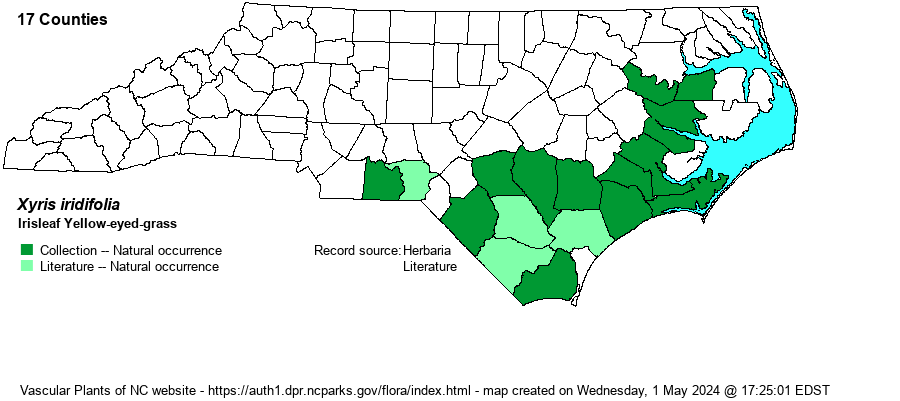| Section 5 » Family Xyridaceae |
Show/Hide Synonym
| taxonName | relationship | relatedTaxonName | relatedTaxonRefText | relComments |
|---|
|
|
|
|
|
|
| Xyris iridifolia | = | Xyris laxifolia var. iridifolia | Flora of North America (1993b, 1997, 2000, 2002a, 2002b, 2003a, 2004b, 2005, 2006a, 2006b, 2006c, 2007a, 2009, 2010) | | | Xyris iridifolia | = | Xyris laxifolia var. iridifolia | Kartesz (1999) | | | Xyris iridifolia | = | Xyris laxifolia var. iridifolia | | | | Xyris iridifolia | = | Xyris laxifolia var. iridifolia | Wunderlin & Hansen Flora of Florida (3) | | | Xyris iridifolia | = | Xyris laxifolia var. iridifolia | Kral in Kubitzki (1998b). Key adapted from X, GW, and Z. | | | Source: Weakley's Flora |
|
| Author | Chapman | |
| Distribution | Flat portions of the Coastal Plain only, except for a slight extension into the Piedmont in Anson County; absent from the Sandhills proper. The Richmond County report needs verification. Should occur in the northern counties, as it does occur in several southeastern VA counties.
Coastal Plain, southeastern VA to northern FL and eastern TX; central TN; Veracruz, Mex. | |
| Abundance | Uncommon. Perhaps this scarcity is mainly due to difficulty of access into some of its swampy habitats. This is a Watch List species, despite it being recorded from 16 counties. The website editors suggest a State Rank of S3 instead of S2, given its wide range in the Coastal Plain. | |
| Habitat | Freshwater marshes, cypress-gum swamps, blackwater river backup channels, floodplain pools. | |
| Phenology | Flowering and fruiting late July - mid September. | |
| Identification | Irisleaf Yellow-eyed-grass has distinctly wide leaves, compared with other species of its size -- up to an inch wide. The leaf bases are pink to maroon and with a broad, translucent margin. The scapes grow 1-2.5 feet tall and the uppermost portion is usually rather flattened, but not as obvious as in Bog Yellow-eyed-grass (X. difformis). Lateral sepals do not project beyond the scales. | |
| Taxonomic Comments | None
Members of Xyris are easy to identify to genus, but can be a challenge to identify species. Careful observation of a few features with a hand-lens is usually sufficient. Close attention must be paid to the flowering head, which is composed of overlapping brown scales. Immediately behind each scale are two brown "lateral sepals"; the margins of these may be feathery or irregularly lacerate (cut into narrow segments) or finely cut into short, comb-like prickles. Lateral sepals may be hidden or a bit longer than each scale. The flowers themselves are usually of little diagnostic value, other than time of flowering -- morning vs. afternoon. Seed size and ornamentation can also be useful characters, but require a dissecting scope to see well. Note also whether leaves and scapes (stems) are twisted and the color of the basal portion. All species have 2-ranked leaves, but in some species the leaves are arranged in a broad, fan-like shape. Finally, note the leaf and stem surface texture -- whether smooth of with little pale bumps. See Godfrey & Wooten (1979) for detailed descriptions and drawings. | |
| Other Common Name(s) | None | |
| State Rank | S2 [S3] | |
| Global Rank | G4G5T4T5 [G4G5] | |
| State Status | W7 [W1] | |
| US Status | | |
| USACE-agcp | | |
| USACE-emp | | |

